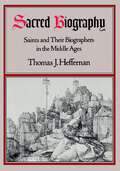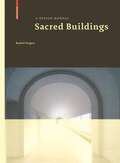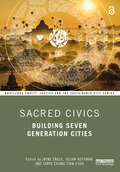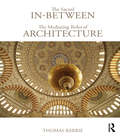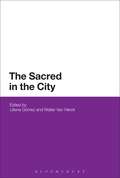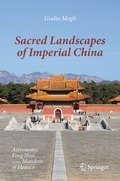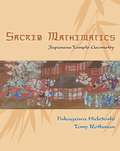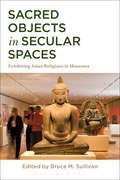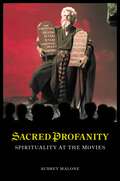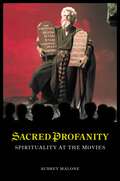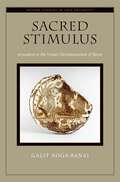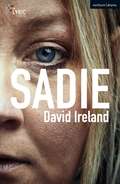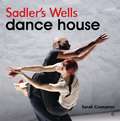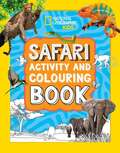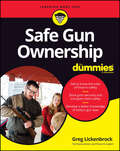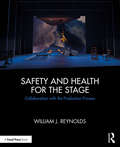- Table View
- List View
Sacred Biography: Saints and Their Biographers in the Middle Ages
by Thomas J. HeffernanThough medieval "saints' lives" are among the oldest literary texts of Western vernacular culture, they are routinely patronized as "pious fiction" by modern historiography. This book demonstrates that to characterize the genre as fiction is to misunderstand the intentions of medieval authors, who were neither credulous fools nor men blinded by piety. Concentrating on English texts, Heffernan reconstructs the medieval perspective and considers sacred biography in relation to the community for which it was written; identifies the genre's rhetorical practices and purposes; and demonstrates the syncretistic way in which the life of the medieval saint was transformed from oral tales to sacred text. In the process, Heffernan not only achieves a more contextually accurate understanding of the medieval saints' lives, but details a new critical method that has important implications for the practice of textual criticism.
Sacred Buildings: A Design Manual (Design Manuals)
by Rudolf Stegers10 ChurchArchitecture PastandPresent RudolfStegers Faith and Religion in the Present Day / Historicismversus Modernity /The Church in the City / EcclesiasticArchitecture from the athto the 19th Century /The Development of Modern Church Architecture / At the Beginning ofthe zist Century /The Sacred and its Relevance for Church Architecture Today 38 SynagogueArchitectureinthe Recent PastandPresent Roman HoHenstein Synagogue Architecture in the zoth Century / Pioneering New Buildings from Louis Kahn to Mario Botta /The Design of the Synagogue Space /ATheory of Synagogue Design / Architectonic Symbols in Germany /Tradition over Experimentation in the United States 46 MosqueArchitecture PastandPresent NegarHakim The Formation and Expansion of Islam / The Mosque as the Centre of Religious Life / The Four Types of Mosques / zoth-Century Mosque Architecture in the Islamic World / 20th-Century Mosque Architecture in the Nations ofthe Diaspora /The Spatial Programme and Arrangement of Modern-DayMosques 54 Acousticsin SacredBuildings Dorothea BaumannandChristina Niederstatter The Sound of Space as a Symbol ofthe Sacred /Architectural Acoustics - The Conflict between Resonance and Clarity / Sound and Sound Propagation / Geometric Analysis / Reflection and Diffraction / Reverberation Time and Absorption / The Number ofPeople / Materials / Special Aspects of Acoustics in Sacred Spaces /Acoustic Analysis 60 Lightin SacredBuildings Eva-Maria Kreuz Light in Churches / Light in Synagogues / Light in Mosques Selection ofProjects CHURCHES AXIAL PLAN CENTRALISE D PLAN 100 146 TornbjergChurch Paper Church Odense Kobe 70 118 Fogh & FolnerArkitektfirma Shigeru Ban Architects Church Centre Church of Our Lady of Lourdes
Sacred Civics: Building Seven Generation Cities (Routledge Equity, Justice and the Sustainable City series)
by Jayne EngleSacred Civics argues that societal transformation requires that spirituality and sacred values are essential to reimagining patterns of how we live, organize and govern ourselves, determine and distribute wealth, inhabit and design cities, and construct relationships with others and with nature. The book brings together transdisciplinary and global academics, professionals, and activists from a range of backgrounds to question assumptions that are fused deep into the code of how societies operate, and to draw on extraordinary wisdom from ancient Indigenous traditions; to social and political movements like Black Lives Matter, the commons, and wellbeing economies; to technologies for participatory futures where people collaborate to reimagine and change culture. Looking at cities and human settlements as the sites of transformation, the book focuses on values, commons, and wisdom to demonstrate that how we choose to live together, to recognize interdependencies, to build, grow, create, and love—matters. Using multiple methodologies to integrate varied knowledge forms and practices, this truly ground-breaking volume includes contributions from renowned and rising voices. Sacred Civics is a must-read for anyone interested in intersectional discussions on social justice, inclusivity, participatory design, healthy communities, and future cities.
Sacred Civics: Building Seven Generation Cities (Routledge Equity, Justice and the Sustainable City series)
by Jayne Engle Julian Agyeman Tanya Chung-Tiam-FookSacred Civics argues that societal transformation requires that spirituality and sacred values are essential to reimagining patterns of how we live, organize and govern ourselves, determine and distribute wealth, inhabit and design cities, and construct relationships with others and with nature. The book brings together transdisciplinary and global academics, professionals, and activists from a range of backgrounds to question assumptions that are fused deep into the code of how societies operate, and to draw on extraordinary wisdom from ancient Indigenous traditions; to social and political movements like Black Lives Matter, the commons, and wellbeing economies; to technologies for participatory futures where people collaborate to reimagine and change culture. Looking at cities and human settlements as the sites of transformation, the book focuses on values, commons, and wisdom to demonstrate that how we choose to live together, to recognize interdependencies, to build, grow, create, and love—matters. Using multiple methodologies to integrate varied knowledge forms and practices, this truly ground-breaking volume includes contributions from renowned and rising voices. Sacred Civics is a must-read for anyone interested in intersectional discussions on social justice, inclusivity, participatory design, healthy communities, and future cities.
The Sacred In-Between: The Mediating Roles of Architecture
by Thomas BarrieThe sacred place was, and still is, an intermediate zone created in the belief that it has the ability to co-join the religious aspirants to their gods. An essential means of understanding this sacred architecture is through the recognition of its role as an ‘in-between’ place. Establishing the contexts, approaches and understandings of architecture through the lens of the mediating roles often performed by sacred architecture, this book offers the reader an extraordinary insight into the forces behind these extraordinary buildings. Written by a well-known expert in the field, the book draws on a unique range of cases, reflecting on these inspiring places, their continuing ontological significance and the lessons they can offer today. Fascinating reading for anyone interested in sacred architecture.
The Sacred In-Between: The Mediating Roles of Architecture
by Thomas BarrieThe sacred place was, and still is, an intermediate zone created in the belief that it has the ability to co-join the religious aspirants to their gods. An essential means of understanding this sacred architecture is through the recognition of its role as an ‘in-between’ place. Establishing the contexts, approaches and understandings of architecture through the lens of the mediating roles often performed by sacred architecture, this book offers the reader an extraordinary insight into the forces behind these extraordinary buildings. Written by a well-known expert in the field, the book draws on a unique range of cases, reflecting on these inspiring places, their continuing ontological significance and the lessons they can offer today. Fascinating reading for anyone interested in sacred architecture.
The Sacred in the City
by Liliana Gómez Walter Van HerckThis book reflects the way in which the city interacts with the sacred in all its many guises, with religion and the human search for meaning in life. As the process of urbanization of society is accelerating thus giving an increasing importance to cities and the 'metropolis', it is relevant to investigate the social or cultural cohesion that these urban agglomerations manifest. Religion is keenly observed as witnessing a growth, crucially impacting cultural and political dynamics, as well as determining the emergence of new sacred symbols and their inscription in urban spaces worldwide. The sacred has become an important category of a new interpretation of social and cultural transformation processes. From a unique broader perspective, the volume focuses on the relationship between the city and the sacred. Taking a multidisciplinary approach, combining the expertise of philosophers, historians, architects, social geographers, sociologists and anthropologists, it draws a nuanced picture of the different layers of religion, of the sacred and its diverse forms within the city, with examples from Europe, South America and the Caribbean, and Africa.
The Sacred in the City
by Liliana Gómez and Walter Van HerckThis book reflects the way in which the city interacts with the sacred in all its many guises, with religion and the human search for meaning in life. As the process of urbanization of society is accelerating thus giving an increasing importance to cities and the 'metropolis', it is relevant to investigate the social or cultural cohesion that these urban agglomerations manifest. Religion is keenly observed as witnessing a growth, crucially impacting cultural and political dynamics, as well as determining the emergence of new sacred symbols and their inscription in urban spaces worldwide. The sacred has become an important category of a new interpretation of social and cultural transformation processes. From a unique broader perspective, the volume focuses on the relationship between the city and the sacred. Taking a multidisciplinary approach, combining the expertise of philosophers, historians, architects, social geographers, sociologists and anthropologists, it draws a nuanced picture of the different layers of religion, of the sacred and its diverse forms within the city, with examples from Europe, South America and the Caribbean, and Africa.
Sacred Landscapes of Imperial China: Astronomy, Feng Shui, and the Mandate of Heaven
by Giulio MagliThis book analyses the magnificent imperial necropolises of ancient China from the perspective of Archaeoastronomy, a science which takes into account the landscape in which ancient monuments are placed, focusing especially but not exclusively on the celestial aspects. The power of the Chinese emperors was based on the so-called Mandate of Heaven: the rulers were believed to act as intermediaries between the sky gods and the Earth, and consequently, the architecture of their tombs, starting from the world-famous mausoleum of the first emperor, was closely linked to the celestial cycles and to the cosmos. This relationship, however, also had to take into account various other factors and doctrines, first the Zhao-Mu doctrine in the Han period and later the various forms of Feng Shui. As a result, over the centuries, diverse sacred landscapes were constructed. Among the sites analysed in the book are the “pyramids” of Xi’an from the Han dynasty, the mountain tombs of the Tang dynasty, and the Ming and Qing imperial tombs. The book explains how considerations such as astronomical orientation and topographical orientation according to the principles of Feng Shui played a fundamental role at these sites.
Sacred Mathematics: Japanese Temple Geometry
by Fukagawa Hidetoshi Tony RothmanBetween the seventeenth and nineteenth centuries Japan was totally isolated from the West by imperial decree. During that time, a unique brand of homegrown mathematics flourished, one that was completely uninfluenced by developments in Western mathematics. People from all walks of life--samurai, farmers, and merchants--inscribed a wide variety of geometry problems on wooden tablets called sangaku and hung them in Buddhist temples and Shinto shrines throughout Japan. Sacred Mathematics is the first book published in the West to fully examine this tantalizing--and incredibly beautiful--mathematical tradition. Fukagawa Hidetoshi and Tony Rothman present for the first time in English excerpts from the travel diary of a nineteenth-century Japanese mathematician, Yamaguchi Kanzan, who journeyed on foot throughout Japan to collect temple geometry problems. The authors set this fascinating travel narrative--and almost everything else that is known about temple geometry--within the broader cultural and historical context of the period. They explain the sacred and devotional aspects of sangaku, and reveal how Japanese folk mathematicians discovered many well-known theorems independently of mathematicians in the West--and in some cases much earlier. The book is generously illustrated with photographs of the tablets and stunning artwork of the period. Then there are the geometry problems themselves, nearly two hundred of them, fully illustrated and ranging from the utterly simple to the virtually impossible. Solutions for most are provided. A unique book in every respect, Sacred Mathematics demonstrates how mathematical thinking can vary by culture yet transcend cultural and geographic boundaries.
Sacred Objects in Secular Spaces: Exhibiting Asian Religions in Museums
by Bruce M. SullivanWe have long recognized that many objects in museums were originally on display in temples, shrines, or monasteries, and were religiously significant to the communities that created and used them. How, though, are such objects to be understood, described, exhibited, and handled now that they are in museums? Are they still sacred objects, or formerly sacred objects that are now art objects, or are they simultaneously objects of religious and artistic significance, depending on who is viewing the object? These objects not only raise questions about their own identities, but also about the ways we understand the religious traditions in which these objects were created and which they represent in museums today. Bringing together religious studies scholars and museum curators, Sacred Objects in Secular Spaces is the first volume to focus on Asian religions in relation to these questions. The contributors analyze an array of issues related to the exhibition in museums of objects of religious significance from Hindu, Buddhist, and Sikh traditions. The "lives†? of objects are considered, along with the categories of "sacred†? and "profane†?, "religious†? and "secular†?. As interest in material manifestations of religious ideas and practices continues to grow, Sacred Objects in Secular Spaces is a much-needed contribution to religious and Asian studies, anthropology of religion and museums studies.
Sacred Objects in Secular Spaces: Exhibiting Asian Religions in Museums
by Bruce M. SullivanWe have long recognized that many objects in museums were originally on display in temples, shrines, or monasteries, and were religiously significant to the communities that created and used them. How, though, are such objects to be understood, described, exhibited, and handled now that they are in museums? Are they still sacred objects, or formerly sacred objects that are now art objects, or are they simultaneously objects of religious and artistic significance, depending on who is viewing the object? These objects not only raise questions about their own identities, but also about the ways we understand the religious traditions in which these objects were created and which they represent in museums today. Bringing together religious studies scholars and museum curators, Sacred Objects in Secular Spaces is the first volume to focus on Asian religions in relation to these questions. The contributors analyze an array of issues related to the exhibition in museums of objects of religious significance from Hindu, Buddhist, and Sikh traditions. The “lives” of objects are considered, along with the categories of “sacred” and “profane”, “religious” and “secular”. As interest in material manifestations of religious ideas and practices continues to grow, Sacred Objects in Secular Spaces is a much-needed contribution to religious and Asian studies, anthropology of religion and museums studies.
Sacred Profanity: Spirituality at the Movies
by Aubrey MaloneThis book offers a history of films with Biblical, spiritual, and supernatural themes.This volume follows the evolution of one of the Hollywood's longest running thematic concerns. From the silent era to the present, Sacred Profanity: Spirituality at the Movies examines the rich diversity of films with spiritual themes—films that reflect our own fascination with the divine and supernatural, while evoking the specific times in which they were created.From Birth of a Nation to Angels and Demons, Sacred Profanity discusses over 180 films with an insightful, movie lover's approach. Coverage encompasses Biblical stories like King of Kings; films about spiritual characters, such as The Nun's Story; foreign masterpieces like The Seventh Seal; movies that incorporate spiritual symbolism, such as Taxi Driver and Cool Hand Luke; horrifying visions of the Satanic like The Exorcist, and controversial works like The Last Temptation of Christ. The book also looks at the history of Hollywood's attempt to maintain moral order through censorship, as well as the growing influence of filmmakers' own spiritual beliefs on the movies we see.
Sacred Profanity: Spirituality at the Movies
by Aubrey MaloneThis book offers a history of films with Biblical, spiritual, and supernatural themes.This volume follows the evolution of one of the Hollywood's longest running thematic concerns. From the silent era to the present, Sacred Profanity: Spirituality at the Movies examines the rich diversity of films with spiritual themes—films that reflect our own fascination with the divine and supernatural, while evoking the specific times in which they were created.From Birth of a Nation to Angels and Demons, Sacred Profanity discusses over 180 films with an insightful, movie lover's approach. Coverage encompasses Biblical stories like King of Kings; films about spiritual characters, such as The Nun's Story; foreign masterpieces like The Seventh Seal; movies that incorporate spiritual symbolism, such as Taxi Driver and Cool Hand Luke; horrifying visions of the Satanic like The Exorcist, and controversial works like The Last Temptation of Christ. The book also looks at the history of Hollywood's attempt to maintain moral order through censorship, as well as the growing influence of filmmakers' own spiritual beliefs on the movies we see.
Sacred Stimulus: Jerusalem in the Visual Christianization of Rome (Oxford Studies in Late Antiquity)
by Galit Noga-BanaiSacred Stimulus offers a thorough exploration of Jerusalem's role in the formation and formulation of Christian art in Rome during the fourth and fifth centuries. The visual vocabulary discussed by Galit Noga-Banai gives an alternative access point to the mnemonic efforts conceived while Rome converted to Christianity: not in comparison to pagan art in Rome, not as reflecting the struggle with the emergence of New Rome in the East (Constantinople), but rather as visual expressions of the confrontation with earthly Jerusalem and its holy places. After all, Jerusalem is where the formative events of Christianity occurred and were memorialized. Sacred Stimulus argues that, already in the second half of the fourth century, Rome constructed its own set of holy sites and foundational myths, while expropriating for its own use some of Jerusalem's sacred relics, legends, and sites. Relying upon well-known and central works of art, including mosaic decoration, sarcophagi, wall paintings, portable art, and architecture, Noga-Banai exposes the omnipresence of Jerusalem and its position in the genesis of Christian art in Rome. Noga-Banai's consideration of earthly Jerusalem as a conception that Rome used, or had to take into account, in constructing its own new Christian ideological and cultural topography of the past, sheds light on connections and analogies that have not necessarily been preserved in the written evidence, and offers solutions to long-standing questions regarding specific motifs and scenes.
Sacred Stimulus: Jerusalem in the Visual Christianization of Rome (Oxford Studies in Late Antiquity)
by Galit Noga-BanaiSacred Stimulus offers a thorough exploration of Jerusalem's role in the formation and formulation of Christian art in Rome during the fourth and fifth centuries. The visual vocabulary discussed by Galit Noga-Banai gives an alternative access point to the mnemonic efforts conceived while Rome converted to Christianity: not in comparison to pagan art in Rome, not as reflecting the struggle with the emergence of New Rome in the East (Constantinople), but rather as visual expressions of the confrontation with earthly Jerusalem and its holy places. After all, Jerusalem is where the formative events of Christianity occurred and were memorialized. Sacred Stimulus argues that, already in the second half of the fourth century, Rome constructed its own set of holy sites and foundational myths, while expropriating for its own use some of Jerusalem's sacred relics, legends, and sites. Relying upon well-known and central works of art, including mosaic decoration, sarcophagi, wall paintings, portable art, and architecture, Noga-Banai exposes the omnipresence of Jerusalem and its position in the genesis of Christian art in Rome. Noga-Banai's consideration of earthly Jerusalem as a conception that Rome used, or had to take into account, in constructing its own new Christian ideological and cultural topography of the past, sheds light on connections and analogies that have not necessarily been preserved in the written evidence, and offers solutions to long-standing questions regarding specific motifs and scenes.
Sadie (Modern Plays)
by David IrelandSadie has a one-night stand with the new office temp, Joao, but it develops into something much more serious when Joao reveals he's in love with her. Sadie is flattered but she has a long history of terrible relationships. She wonders if it's even possible for her to be happy in love? To answer that question, she calls upon her long dead uncle Red and her abusive ex-husband Clark, as well as her new therapist Mairead. Together they help her face some horrifying truths she's kept hidden for too long. Lyric Theatre Belfast, in association with Stephen Rea's Field Day Theatre Company, bring this powerful new play to the stage, to be broadcast on BBC Four as part of BBC Arts 'Lights up' for the new Culture in Quarantine Season – a celebration of British theatre, bringing newly-recorded staged productions from UK theatres to audiences across television, radio, iPlayer and BBC Sounds.Directed by Conleth Hill (Lord Varys, Game of Thrones) it stars award-winning actress Abigail McGibbon.
Sadie (Modern Plays)
by David IrelandSadie has a one-night stand with the new office temp, Joao, but it develops into something much more serious when Joao reveals he's in love with her. Sadie is flattered but she has a long history of terrible relationships. She wonders if it's even possible for her to be happy in love? To answer that question, she calls upon her long dead uncle Red and her abusive ex-husband Clark, as well as her new therapist Mairead. Together they help her face some horrifying truths she's kept hidden for too long. Lyric Theatre Belfast, in association with Stephen Rea's Field Day Theatre Company, bring this powerful new play to the stage, to be broadcast on BBC Four as part of BBC Arts 'Lights up' for the new Culture in Quarantine Season – a celebration of British theatre, bringing newly-recorded staged productions from UK theatres to audiences across television, radio, iPlayer and BBC Sounds.Directed by Conleth Hill (Lord Varys, Game of Thrones) it stars award-winning actress Abigail McGibbon.
Sadler's Wells - Dance House: Dance House
by Sarah CromptonSadler’s Wells is a powerhouse, an engine room, of dance. It welcomes the best dance companies from Britain and around the world. But its significance is that it commissions the best choreographers, designers, musicians and artists to create new and exciting dance. In words and pictures this book celebrates that inspirational process. Based on interviews with artists including Matthew Bourne, Sylvie Guillem, Akram Khan, Russell Maliphant, Wayne McGregor and Hofesh Shechter, Sadler’s Wells Dance House discovers how this theatre and its creative impulses have shaped the course of dance in the twenty-first century. From classical to hip hop, from the popular successes to the divisive controversies, Sadler’s Wells Dance House tells the story of a theatre that is an international creative hub for all the best of dance today.
Safe Gun Ownership For Dummies
by Greg LickenbrockA straightforward guide to being smart with your firearm With gun sales at an all-time high in the U.S., easy-to-understand advice on storing and possessing guns safely is at an all-time premium. Safe Gun Ownership For Dummies paves the way for new and novice gun owners to learn the basics of firearm ownership in a non-partisan tone. This book helps gun owners thoroughly explore the rules of gun safety and adopt the habits of savvy firearm aficionados. Written by a firearms expert and analyst who has reviewed hundreds of firearms along with gun safety and storage options, this guide helps you develop a safety mindset and apply practices to assure you and your family avoid harm. Learn, internalize, and apply the rules of gun safety Understand federal, state, and local gun laws Find a good gun safety course for hands-on practice Store and transport your firearm securelyWhen it&’s time to start training on your new firearm and the safety rules of gun ownership, Safe Gun Ownership For Dummies is at the ready with everything you need to know to make safety your aim.
Safe Gun Ownership For Dummies
by Greg LickenbrockA straightforward guide to being smart with your firearm With gun sales at an all-time high in the U.S., easy-to-understand advice on storing and possessing guns safely is at an all-time premium. Safe Gun Ownership For Dummies paves the way for new and novice gun owners to learn the basics of firearm ownership in a non-partisan tone. This book helps gun owners thoroughly explore the rules of gun safety and adopt the habits of savvy firearm aficionados. Written by a firearms expert and analyst who has reviewed hundreds of firearms along with gun safety and storage options, this guide helps you develop a safety mindset and apply practices to assure you and your family avoid harm. Learn, internalize, and apply the rules of gun safety Understand federal, state, and local gun laws Find a good gun safety course for hands-on practice Store and transport your firearm securelyWhen it’s time to start training on your new firearm and the safety rules of gun ownership, Safe Gun Ownership For Dummies is at the ready with everything you need to know to make safety your aim.
Safeguarding Intangible Cultural Heritage: A Practical Interpretation of the 2003 UNESCO Convention (Elgar International Law and Practice series)
by Janet BlakeThis book presents a detailed analysis of the different approaches and measures for implementing the requirements of UNESCO’s 2003 Convention on Safeguarding Intangible Cultural Heritage (the Convention) and a practical interpretation of that treaty, based on the experience of States’ Parties and other primary actors. The book considers the interests of multiple stakeholders and takes account of how the Convention interacts with other international law regimes pertaining to both human rights and sustainable development.Key Features:Provides clear and concise information of the definition, scope and significance of intangible cultural heritageUtilises a wide-range of case studies to illustrate the application of the Convention on the ground.Considers the position of multiple stakeholders including national heritage organisations and non-state actorsOutlines practical strategies and solutions for protecting and promoting cultural heritage and looks ahead to potential future developments in this field.Easy to follow structure, mapping out the treaty’s provisions thematically and highlighting their practical applicationProviding accessible and focused analysis, this book will be essential reading for lawyers and practitioners involved in the protection of intangible cultural heritage from both governmental and non-governmental institutions. The book will also be a valuable resource to academics and researchers working across various disciplines including law, heritage, and anthropology.
Safety and Health for the Stage: Collaboration with the Production Process
by William J. ReynoldsSafety and Health for the Stage: Collaboration with the Production Process is a practical guide to integrating safety and health into the production process for live entertainment in the context of compliance with applicable codes, standards, and recommended practices. This book explores the need for safety and health to become an integral aspect of theatre production and live entertainment, focusing on specific steps to take and policies to employ to bring a safety and health program into full collaboration in the production process. Readers will learn how to comply with legal codes and standards as they initiate and implement an effective safety and health program in their theatre production organization or academic theatre department. The book includes references and links to other industry-specific safety and health resources, as well as a Glossary of Safety and Health Terms to navigate the safety and health jargon in the context of theatre and live entertainment. Safety and Health for the Stage: Collaboration with the Production Process provides links to electronic versions of sample safety and health programs, industry-specific policies and recommended practices, and forms and templates related to many of the topics covered in the book. Written for practitioners who are engaged in all aspects of theatre production and live entertainment, as well as educators who train and influence the next generations of these practitioners, this book is an essential resource for creating a positive culture of safety in live entertainment.
Safety and Health for the Stage: Collaboration with the Production Process
by William J. ReynoldsSafety and Health for the Stage: Collaboration with the Production Process is a practical guide to integrating safety and health into the production process for live entertainment in the context of compliance with applicable codes, standards, and recommended practices. This book explores the need for safety and health to become an integral aspect of theatre production and live entertainment, focusing on specific steps to take and policies to employ to bring a safety and health program into full collaboration in the production process. Readers will learn how to comply with legal codes and standards as they initiate and implement an effective safety and health program in their theatre production organization or academic theatre department. The book includes references and links to other industry-specific safety and health resources, as well as a Glossary of Safety and Health Terms to navigate the safety and health jargon in the context of theatre and live entertainment. Safety and Health for the Stage: Collaboration with the Production Process provides links to electronic versions of sample safety and health programs, industry-specific policies and recommended practices, and forms and templates related to many of the topics covered in the book. Written for practitioners who are engaged in all aspects of theatre production and live entertainment, as well as educators who train and influence the next generations of these practitioners, this book is an essential resource for creating a positive culture of safety in live entertainment.
